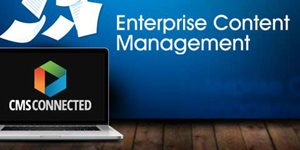What Will Drive the ECM Market in 2017?
As you may recall, in the beginning of 2016, I encapsulated the Enterprise Content Management (ECM)  market, the key trends, and the issues. Since that particular article has garnered a great viewership from you, the CMS-Connected readers, I wanted to take to my keyboard to write another market overview article for the coming year.
market, the key trends, and the issues. Since that particular article has garnered a great viewership from you, the CMS-Connected readers, I wanted to take to my keyboard to write another market overview article for the coming year.
Before diving into what’s next in 2017, let’s have a glance at what happened to the market in 2016. Like every year, Gartner published its annual report, The Magic Quadrant for Enterprise Content Management, however, this year the Stamford, Conn.-based research firm updated its description to most accurately define the industry. The analyst firm terms enterprise content management as follows: "ECM is a set of services and microservices, embodied either as an integrated product suite or as separate applications that share common APIs and repositories, to exploit diverse content types, and serve multiple constituencies and numerous use cases across an organization.” Moreover, the changes are seen not only in the definition of the industry but also in the definition of the inclusion criteria. You can read the brief explanation of the criteria changes from 2015, here.
Last year, I mentioned about the prediction on the market size by MarketandMarkets. This year, that prediction has also been updated by the research firm, and the ECM market size is expected to grow from USD 28.10 Billion in 2016 to USD 66.27 Billion by 2021, at a Compound Annual Growth Rate (CAGR) of 18.7% during the forecast period, according to MarketsandMarkets.
Geographically, while North America holds the largest market share, the Asia/Pacific (APAC) region is by far the fastest-growing market for enterprise content management (ECM) solutions. On the other hand, the recent U.K. referendum decision to leave the EU has created uncertainty, thereby some analysis firms such as Gartner predict that a further slowdown and a limited growth of investment in this market over the next two years.
ECM Key Trends in 2017
Omnichannel
The once well-defined line between content marketing channels is now shrinking. In fact, research by Aspect Software suggests that about 91% of customers want to pick up where they left off, from one channel to the next. Successful organizations recognize the importance of creating a consistent experience across all digital touch points, and useful ECM platforms incorporate omnichannel features to meet today’s customers’ expectation.
The more channels that emerge for customer engagement, the more omnichannel strategy becomes important, and content is, arguably, the heart and soul of every strategy. To support an omnichannel content strategy, organizations need agile technology capabilities that simplify global campaigns, improve the customer experience, and increase productivity for marketing managers. Therefore, during the CMS Insider segment of the CMS-Connected Show aired on September 29th, we asked Industry Analyst Scott Liewehr to give us his in-depth insight on how a CMS supports omnichannel. Here’s what he had to say:
Cloud
The explosive growth of unstructured content is an issue for many organizations. In fact, according to the Economist, 80 percent of content used by knowledge workers for core revenue generation activities is unstructured, while content is doubling every 90 days. To tackle regulatory and statutory requirements, most enterprises have started to captivate the power of the cloud. IDC expects spending on cloud software to double from $57.8 billion in 2015 to $112.8 billion in 2019.
Alfresco Software is one of the enterprise content management (ECM) providers that announced early  access availability of its platform as a single-tenant managed service hosted in an Amazon Web Services Virtual Private Cloud this year. John Newton, Co-founder, CTO and Chairman of Alfresco Software, explained the motivation behind their new offering: “As security demands increase at the same time that data center costs rise, customers are looking for virtual private clouds to reduce costs and better secure critical business information. Large and regulated companies want airtight control of their mission-critical files, which can be over half the files in an organization, but without the hassle of huge data centers.”
access availability of its platform as a single-tenant managed service hosted in an Amazon Web Services Virtual Private Cloud this year. John Newton, Co-founder, CTO and Chairman of Alfresco Software, explained the motivation behind their new offering: “As security demands increase at the same time that data center costs rise, customers are looking for virtual private clouds to reduce costs and better secure critical business information. Large and regulated companies want airtight control of their mission-critical files, which can be over half the files in an organization, but without the hassle of huge data centers.”
Another reason, is that by the year 2020, it is estimated that millennials will form 75% of the global workforce, and this new generation is not known for their high tolerance of cumbersome and lacking features, as they are used to working with fast technology solutions. Therefore, the next versions of ECM solutions will need to be able to drive productivity and enable employees to collaborate and share content smoothly, with both personal and corporate technology devices in a secure manner. In other words, the legacy ECM solutions are becoming obsolete and irrelevant. On the other hand, the use of SaaS ECM solutions are rising, and more and more businesses have started shifting to it.
When an organization evaluates to adopt a new technology, one of the first challenges to come to mind is an overwhelming workload that comes with implementation. Therefore, many vendors today, launch cloud-first digital experience platforms to free the customers from the burden of server maintenance, software upgrades, hotfixes, backups, rewriting code and managing plugins.
“They can get off and running quickly without the need to procure and provision servers or storage. A SaaS ECM solution is easy to buy. It is a subscription so it is an operating expense rather than a capital expense,” Melissa Webster, Program Vice President, Content and Digital Media Technologies at IDC, said. “Some ECM solutions also provide cloud options, including hybrid solutions, available both on-premise and in the cloud.”
EMC announced a new suite of cloud-native content apps, called LEAP, at the EMC World Conference in Las Vegas, in an effort to speed companies toward digital transformation. Also, five EMC-authored apps were announced in conjunction with LEAP. Last November, ECD introduced the new Dell EMC LEAP Platform during its customer event, Momentum, in Barcelona. The platform is redesigned as a content management platform featuring a deep set of enterprise-grade content services. In addition to this announcement, ECD also announced the general availability of two additional content management apps. All these major upgrades led the vendor to retain its position in the Leaders' Quadrant of the 2016 Gartner’s Magic Quadrant for Enterprise Content Management for the 13th consecutive time. Therefore, we reached out to Christopher McLaughlin, Chief Marketing Officer, Enterprise Content Division at EMC, to discuss what the new product offerings mean for the future of enterprise content management space:
Personalization
Another important and must-have capability is personalization. Without personalization, engaging with  brands across touchpoints risks revealing the "ugly welding seams in the customer experience," states Gartner's Jake Sorofman. Customers shouldn't feel their transition between touchpoints, snapping them out of the customer experience. This personalization should happen in real time. "No website visitor should be treated as a disposable metric for future predictions," says Sorofman. "Each should be treated as a valued customer at the time of their visit."
brands across touchpoints risks revealing the "ugly welding seams in the customer experience," states Gartner's Jake Sorofman. Customers shouldn't feel their transition between touchpoints, snapping them out of the customer experience. This personalization should happen in real time. "No website visitor should be treated as a disposable metric for future predictions," says Sorofman. "Each should be treated as a valued customer at the time of their visit."
The problem with the personalization technology is that the topic has generated more discussion than results so far. If you are curious about the impediments and what has taken personalization technology so long to truly become mainstream, I address them in one of my recent articles published here at CMS-Connected. However, in this coming year, personalization technologies will finally pick up speed as the growing need for personalized content encourages enterprises to have content management solutions that provide intelligent content frameworks, as well as scales the volume, cost, and complexity of content personalization in place.
Digital Integration
 Duncan Hendy, Content Strategy Manager at Kentico Software said in an interview: “Digital Integration – it gives you valuable insights into how your customers are interacting with your content and allows you to build profiles and define personas so that, no matter which channel your customer views your digital content on, they get a consistent experience that is truly personal to them. By defining the triggers that form the basis of your marketing automation and leveraging your users’ interactions, you can outline an appropriate communication strategy based on their behavior and deliver them content accordingly. Make sure you choose a platform that integrates effectively. Simply forcing together solutions based on how they function individually rather than as a whole results in a poorly delivered digital experience that frustrates your customers and fails to gather the data you actually need to improve it.”
Duncan Hendy, Content Strategy Manager at Kentico Software said in an interview: “Digital Integration – it gives you valuable insights into how your customers are interacting with your content and allows you to build profiles and define personas so that, no matter which channel your customer views your digital content on, they get a consistent experience that is truly personal to them. By defining the triggers that form the basis of your marketing automation and leveraging your users’ interactions, you can outline an appropriate communication strategy based on their behavior and deliver them content accordingly. Make sure you choose a platform that integrates effectively. Simply forcing together solutions based on how they function individually rather than as a whole results in a poorly delivered digital experience that frustrates your customers and fails to gather the data you actually need to improve it.”
As I mentioned earlier, Gartner made some changes to the inclusion criteria, which have resulted in a number of vendors included having dropped from 20 in 2015 to 15 in 2016. One of the new criteria was integration. According to the new rule, the vendor's main ECM product must integrate with at least five business applications (ERP, CRM, HR, productivity suite or other business process applications) either natively or through connectors or add-on components. So it is not surprising to see integration among the ECM trends.
Globalization
According to 2016 Forrester Consulting study commissioned by SDL, 92% of companies face challenges as they translate content into different languages and only 29% integrate their content management system with a translation management system or language service provider. The innovative language technology is still in the early stages of adoption, and therein lies the opportunity for growth in the space. Factors driving this demand include continued growth in global mobile and e-commerce; the internet of things (IoT); and legislation requiring access to language services for immigrants, refugees, in the courts, and for public safety.
During my interview with Peggy Chen, Chief Marketing Officer at SDL, she said: “In 2017, more companies will start to think about how they need to look at the topic of language globalization transcreation in the context of what they’re currently doing with their actual content. I think, this should be entirely powered by digitalization. For hundreds of years, we were wired with human connections, now we are in the digital era, more people can actually communicate and get access to a lot more information but what has changed is that you don’t have a direct connection to the content. In the digital world, there is really no country border anymore and people, at the end of the day, want to be able to understand each other. We believe that in this next age, which is the Age of Understanding, the humanized digital experiences integrated with the immigration of content and language will go a long way, so people can understand each other better.“ You can read the full interview, here.
will start to think about how they need to look at the topic of language globalization transcreation in the context of what they’re currently doing with their actual content. I think, this should be entirely powered by digitalization. For hundreds of years, we were wired with human connections, now we are in the digital era, more people can actually communicate and get access to a lot more information but what has changed is that you don’t have a direct connection to the content. In the digital world, there is really no country border anymore and people, at the end of the day, want to be able to understand each other. We believe that in this next age, which is the Age of Understanding, the humanized digital experiences integrated with the immigration of content and language will go a long way, so people can understand each other better.“ You can read the full interview, here.
On the top of these trends, by 2018, Gartner expects to see:
-
Half of the enterprises will manage content on hybrid systems (cloud/on-premise).
-
More than one-fifth of businesses will be managing content from multiple organizations.
-
File synchronization and sharing will be a standard built-in ECM function.
-
Half of big-name ECM vendors will re-architect their software to be cloud-based.
-
One-fifth of business content will be machine authored.
The growth in the enterprise content management space doesn’t seem to be impaired anytime soon, and I would say the opportunity lies therein for both enterprises and enterprise content management vendors that want to cultivate brand loyalty with today’s digitally-savvy and demanding customers.
Here at CMS-Connected, we will continue to share the predictions on various segments of the tech industry for 2017. Meanwhile, feel free to go ahead and check out the other CMSC prediction articles titled 6 Enterprise Tech Trend Predictions for 2017 and Beyond, 4 B2B Content Marketing Trends You Need To Know for 2017, Internet of Things Forecasts & Best Practices, and 7 Emerging eCommerce Technology Innovations as investing in these and other emerging technologies is certainly a smart move if you want to set your business up to remain with or ahead of the curve over the next 5 to 10 years.

Venus Tamturk
Venus is the Media Reporter for CMS-Connected, with one of her tasks to write thorough articles by creating the most up-to-date and engaging content using B2B digital marketing. She enjoys increasing brand equity and conversion through the strategic use of social media channels and integrated media marketing plans.